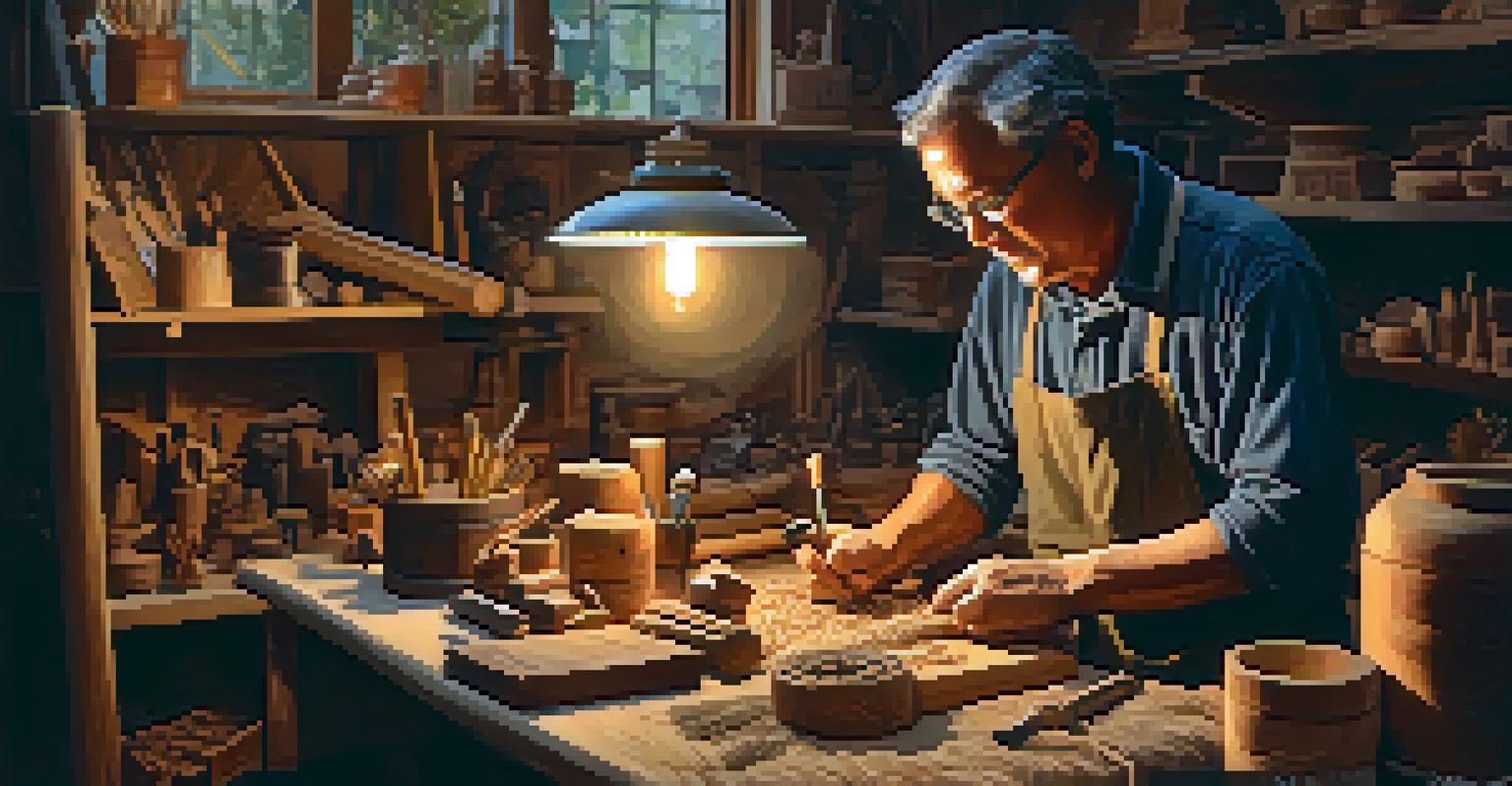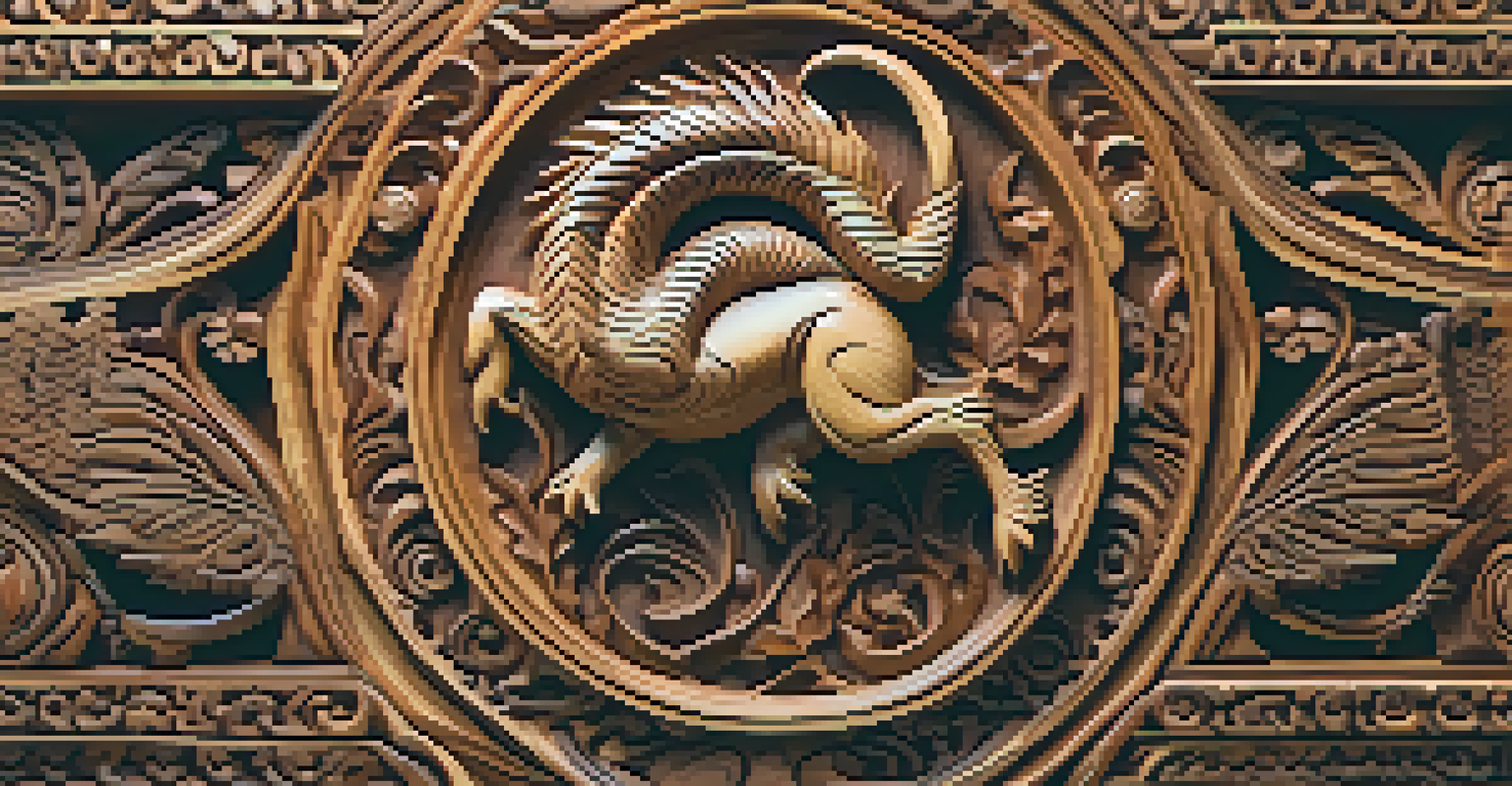Durability: Stone Carving vs. Wood Carving Outcomes

Understanding the Basics of Stone and Wood Carving
Carving is an ancient art form, and while both stone and wood are popular materials, they offer distinct characteristics. Stone carving, often associated with monumental sculptures, involves chiseling harder materials like granite or marble. In contrast, wood carving typically employs softer woods like pine or cedar, allowing for more intricate designs but with different challenges.
Art is not freedom from discipline, but disciplined freedom.
The choice between stone and wood carving often hinges on the desired outcome. Stone has a reputation for longevity and resilience, making it ideal for outdoor sculptures that withstand the elements. Meanwhile, wood can be more forgiving for intricate details, allowing artisans to express creativity in unique ways, although it may require more maintenance over time.
Both mediums have their unique charms. Picture a grand stone statue standing strong against time, and then visualize delicate wooden carvings that tell stories through their intricate patterns. Each material not only has its own aesthetic appeal but also reflects the skills and intentions of the artist.
Durability: How Stone Carving Stands the Test of Time
Stone carving boasts impressive durability, often lasting centuries if not millennia. Ancient structures and sculptures, like the Pyramids of Giza, highlight how stone can endure harsh weather, erosion, and even human intervention. This durability makes stone a popular choice for monuments and memorials that aim to commemorate significant events or individuals.

The density of stone also plays a crucial role in its longevity. Unlike wood, which can succumb to rot or pests, stone remains impervious to many natural threats. This means that a well-carved stone piece can maintain its integrity even in challenging environments, making it a reliable option for outdoor installations.
Stone Carving: Timeless Durability
Stone carving is renowned for its impressive longevity, making it an ideal choice for outdoor sculptures and monuments.
However, stone carving does have its downsides. The process requires specialized tools and skills, making it more time-consuming and costly than wood carving. Additionally, while stone is resilient, it can be susceptible to cracking under extreme temperature changes, which can impact the overall structure if not properly managed.
Wood Carving: Beauty with a Different Kind of Durability
Wood carving offers a unique aesthetic appeal, often characterized by warmth and organic textures. While it may not match stone in longevity, many wood carvings possess a charm that resonates with audiences. Think of a beautifully detailed wooden figure; it can evoke emotions and connections that are sometimes harder to achieve with stone.
The artist is nothing without the gift, but the gift is nothing without work.
That said, the durability of wood is influenced by various factors, including the type of wood used and the environmental conditions it faces. Hardwoods like oak and mahogany can withstand wear better than softer woods, yet they still require regular maintenance to prevent warping, cracking, or insect damage. This makes understanding the material crucial for preserving the artwork.
Moreover, wood can be treated or sealed to enhance its durability, ensuring it lasts longer even in outdoor settings. Artists often embrace this challenge, using their skills to create pieces that not only look stunning but also stand resilient against time, showcasing the balance between beauty and practicality.
Environmental Impact: Stone vs. Wood Carving
When considering durability, it's essential to factor in the environmental impact of both stone and wood carving. Stone extraction can be resource-intensive, often involving significant disruption to natural landscapes. Quarrying can lead to habitat loss and increased carbon emissions, raising concerns among eco-conscious artists and consumers.
On the other hand, wood carving can be more sustainable if sourced from responsibly managed forests. Artists who prioritize sustainability often seek out reclaimed wood or certified sources that ensure the trees are harvested in an environmentally friendly way. This choice not only contributes to durability but also reflects a commitment to preserving nature.
Wood Carving: Aesthetic Appeal
Wood carving offers unique warmth and intricate designs, allowing artists to express creativity, though it requires more maintenance.
Ultimately, the decision between stone and wood also encompasses ethical considerations. As artists and consumers become more aware of their environmental footprint, the choice of material can significantly impact the artwork's legacy, making it essential to strike a balance between durability and sustainability.
The Role of Maintenance in Carving Outcomes
Regardless of the material, maintenance plays a vital role in the durability of carved pieces. Stone sculptures may need occasional cleaning to remove dirt and algae, especially if displayed outdoors. This simple upkeep can help maintain their appearance and prevent long-term damage, ensuring they continue to impress for generations.
In contrast, wood carvings require more proactive care. Regular treatments with oils or sealants can protect wood from moisture and pests, extending its life significantly. This maintenance is especially crucial for outdoor wooden sculptures, which are more vulnerable to the elements than their stone counterparts.
Ultimately, understanding the maintenance needs of each medium can significantly influence the longevity of the artwork. Artists and collectors alike must consider how much effort they're willing to put in to protect their investments, as proper care can mean the difference between a cherished heirloom and a forgotten relic.
Artistic Intent: How Durability Influences Design Choices
The choice of material often reflects the artist's intent and vision. For instance, a sculptor may opt for stone to convey permanence and strength, aiming to create a piece that feels timeless. This choice can shape not only the final outcome but also the design process, as artists must consider how their vision aligns with the material's characteristics.
Conversely, artists working with wood might embrace its organic qualities, allowing them to experiment with fluid forms and intricate details that may not be as feasible in stone. The flexibility of wood can lead to dynamic designs that evoke movement and life, aligning perfectly with the artist's message.
Environmental Considerations Matter
Choosing between stone and wood involves ethical considerations, as both materials have distinct environmental impacts that artists and consumers must weigh.
Ultimately, durability plays a crucial role in how artists approach their work. By understanding the strengths and limitations of their chosen materials, they can create pieces that resonate with viewers while standing the test of time, ensuring that their artistic visions endure.
Final Thoughts: Choosing Between Stone and Wood Carving
In the end, the choice between stone and wood carving comes down to personal preference, artistic goals, and practical considerations. Both materials offer unique attributes and can produce stunning artworks that resonate with audiences. Understanding the differences in durability helps artists and collectors make informed decisions that align with their vision.
While stone stands out for its enduring strength and historical significance, wood captivates with its warmth and intricate detailing. Each medium tells a story, inviting viewers to appreciate the craftsmanship behind every piece. As one considers the durability of each, it’s essential to recognize the artistry involved in selecting the right material for the desired outcome.

Ultimately, whether you lean towards the timelessness of stone or the organic beauty of wood, both carving forms have their place in the art world. Embrace the journey of exploration, and let your choice reflect your personal connection to these incredible materials.